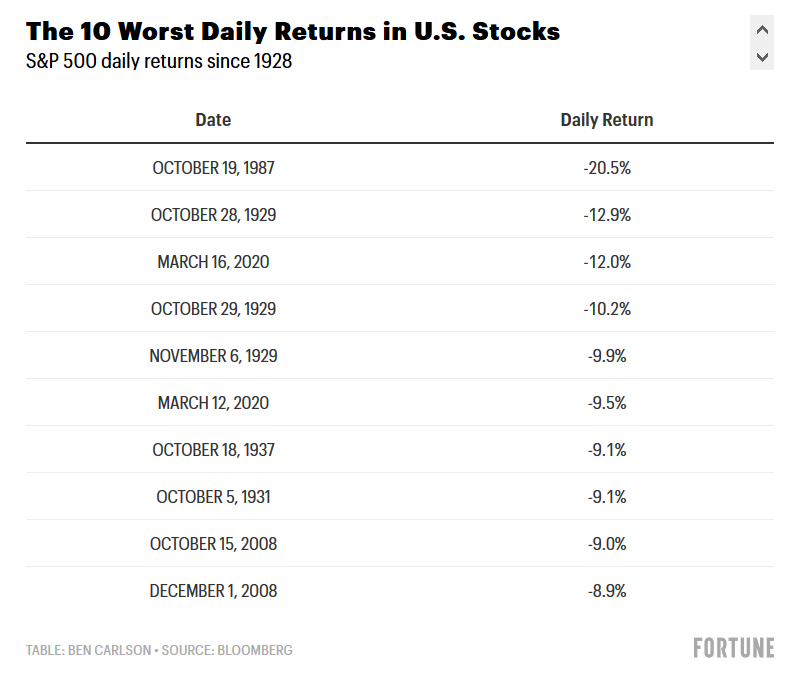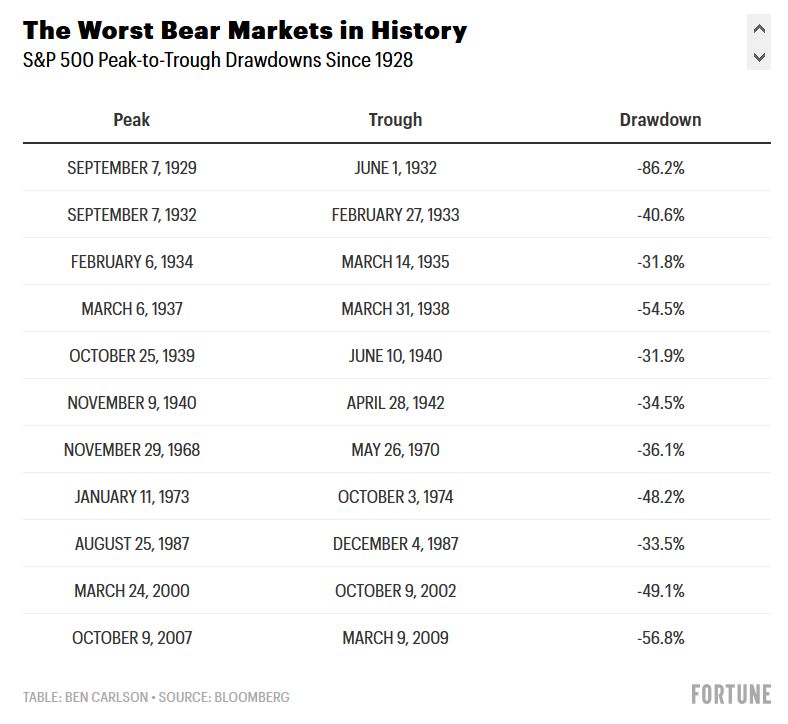美股熊市之后行情如何?或许会有好消息
上周一,标普500指数下跌12%,创下了自1928年以来第三差的单日收益。事实上,美股过去三个交易日中,有两个交易日的单日收益之糟糕,排进了史上前六。

进入这个榜单绝不是好兆头,因为上榜的都是大萧条、大衰退和1937年经济衰退(1929年 - 1932年经济危机之后的一次“回响衰退”)期间的股市暴跌。
新冠病毒引起的恐慌在市场上持续蔓延,美国股市用史上最短的时间进入了熊市,16个交易日下跌了20%,而仅仅两个交易日之后的周一,美股收盘时跌幅已经接近30%。
根据笔者的计算,过去90多年,跌幅达到30%或30%以上的熊市共出现过十一次:

所以目前的这波行情,应该是美国股市最严重的十二次市场崩溃之一。
股市很有可能会继续下跌。没有人知道经济状况会变得多糟糕,因为现在的自我隔离和公司停业,都只是实时采取的一些尝试性措施。情况在好转之前,会变得更糟。
但我们终究会走出低谷,尽管我们现在还看不到复苏的迹象。金融市场会反弹,经济能够自我修复。在此之前,我们要承受巨大的痛苦,但人类是一种强大的物种,我们能够忍受这些痛苦。
许多投资者都不会想到,如果你能够坚持下去,熊市之后往往会有很高的收益率。以下是以往每次熊市之后一年、三年和五年的收益率:

熊市之后一年、三年和五年的平均收益率分别是52%、89%和132%。当然,这些收益率都是从熊市的最低点开始计算。
但没有人知道股市何时触底,因为市场暴跌往往是由于投资者的情绪和从众心理所导致的。股市从当前的水平再出现一轮下跌,这种情况是很有可能发生的。
在下跌达到30%或30%以上的11个熊市中,有6个总下跌幅度超过40%。股市需要从当前的水平继续下跌15%左右,才能达到总计40%的跌幅。
在下跌达到30%或30%以上的11个熊市中,有3个总下跌幅度超过50%。股市需要从当前的水平继续下跌30%左右,才能达到总计50%的跌幅。
2008年10月中旬,沃伦·巴菲特在《纽约时报》上发表了一篇专栏文章,名为《我在买入美国》(Buy American. I am)。当时,标普500指数从高点下跌了近40%,而且美国正经历着自大萧条以来最严重的金融危机。
巴菲特写道:
金融系统一片狼藉,在美国和国外都是如此。金融系统的问题开始慢慢渗入整体经济,而且这种渗透正在变成井喷。短期来看,失业率会继续上升,商业活动会继续萎缩,各大报纸的头条会继续让人恐慌。因此……我正在买入美国股票。
听起来很熟悉吗?
从巴菲特说他正在买入美国股票那天起,股市会继续下跌30%左右。就连世界上最伟大的投资家也没办法在市场下行时预测最低点。
但如果你跟巴菲特在同一天购买了一只标普500指数基金,现在它的价值已经增长了超过220%(已经把近期的暴跌计算在内)。
事实上,没有人能够实时锁定市场的最低点。股市暴跌给投资者带来了一次痛苦的重新校准的机会。对于定期储蓄的人们来说,好消息是市场崩溃之后通常都会有更高的预期收益率。
从长远来看,即使在股市触底之前买进,也能得到丰厚的回报。
本文作者本·卡尔森是一位注册金融分析师,现任里萨兹财富管理公司(Ritholtz Wealth Management)机构资产管理总监。作者可能持有本文中所讨论的证券或资产。(财富中文网)
译者:Biz
上周一,标普500指数下跌12%,创下了自1928年以来第三差的单日收益。事实上,美股过去三个交易日中,有两个交易日的单日收益之糟糕,排进了史上前六。
进入这个榜单绝不是好兆头,因为上榜的都是大萧条、大衰退和1937年经济衰退(1929年 - 1932年经济危机之后的一次“回响衰退”)期间的股市暴跌。
新冠病毒引起的恐慌在市场上持续蔓延,美国股市用史上最短的时间进入了熊市,16个交易日下跌了20%,而仅仅两个交易日之后的周一,美股收盘时跌幅已经接近30%。
根据笔者的计算,过去90多年,跌幅达到30%或30%以上的熊市共出现过十一次:
所以目前的这波行情,应该是美国股市最严重的十二次市场崩溃之一。
股市很有可能会继续下跌。没有人知道经济状况会变得多糟糕,因为现在的自我隔离和公司停业,都只是实时采取的一些尝试性措施。情况在好转之前,会变得更糟。
但我们终究会走出低谷,尽管我们现在还看不到复苏的迹象。金融市场会反弹,经济能够自我修复。在此之前,我们要承受巨大的痛苦,但人类是一种强大的物种,我们能够忍受这些痛苦。
许多投资者都不会想到,如果你能够坚持下去,熊市之后往往会有很高的收益率。以下是以往每次熊市之后一年、三年和五年的收益率:
熊市之后一年、三年和五年的平均收益率分别是52%、89%和132%。当然,这些收益率都是从熊市的最低点开始计算。
但没有人知道股市何时触底,因为市场暴跌往往是由于投资者的情绪和从众心理所导致的。股市从当前的水平再出现一轮下跌,这种情况是很有可能发生的。
在下跌达到30%或30%以上的11个熊市中,有6个总下跌幅度超过40%。股市需要从当前的水平继续下跌15%左右,才能达到总计40%的跌幅。
在下跌达到30%或30%以上的11个熊市中,有3个总下跌幅度超过50%。股市需要从当前的水平继续下跌30%左右,才能达到总计50%的跌幅。
2008年10月中旬,沃伦·巴菲特在《纽约时报》上发表了一篇专栏文章,名为《我在买入美国》(Buy American. I am)。当时,标普500指数从高点下跌了近40%,而且美国正经历着自大萧条以来最严重的金融危机。
巴菲特写道:
金融系统一片狼藉,在美国和国外都是如此。金融系统的问题开始慢慢渗入整体经济,而且这种渗透正在变成井喷。短期来看,失业率会继续上升,商业活动会继续萎缩,各大报纸的头条会继续让人恐慌。因此……我正在买入美国股票。
听起来很熟悉吗?
从巴菲特说他正在买入美国股票那天起,股市会继续下跌30%左右。就连世界上最伟大的投资家也没办法在市场下行时预测最低点。
但如果你跟巴菲特在同一天购买了一只标普500指数基金,现在它的价值已经增长了超过220%(已经把近期的暴跌计算在内)。
事实上,没有人能够实时锁定市场的最低点。股市暴跌给投资者带来了一次痛苦的重新校准的机会。对于定期储蓄的人们来说,好消息是市场崩溃之后通常都会有更高的预期收益率。
从长远来看,即使在股市触底之前买进,也能得到丰厚的回报。
本文作者本·卡尔森是一位注册金融分析师,现任里萨兹财富管理公司(Ritholtz Wealth Management)机构资产管理总监。作者可能持有本文中所讨论的证券或资产。(财富中文网)
译者:Biz
Monday saw the S&P 500 have its third worst daily return since 1928, falling 12%. In fact, two of the past three trading sessions for U.S. stocks have given us two of the six worst daily returns ever.
This is not the greatest company to be in considering this list is littered with losses seen during the Great Depression, Great Recession and 1937 recession which was something of an echo-recession following the 1929-1932 debacle.
As coronavirus panic spread, U.S. stocks just experienced the fastest bear market in history, falling 20% in just 16 trading sessions and finishing the day on Monday down close 30%, which happened just two trading sessions later.
By my calculations, there have been just eleven bear markets with losses of 30% or worse over the past 90-plus years:
So the current iteration would be among the worst dozen or so market crashes in U.S. stocks.
Stocks could always go down further. No one knows how bad things will get economically considering the quarantine and stoppage of businesses are basically experiments being run in real-time. Things are going to get worse before they get better.
It may not feel like it now, but eventually we will recover. Financial markets will come back and the economy will mend itself. There will be much pain and suffering between now and then but we are a strong species and we will endure.
Not many investors are thinking this way but returns following a bear market are pretty good if you can hang on. Here are the one, three and five year returns following each of the past bear markets:
Average returns following bear markets have been 52%, 89% and 132% respectively over the ensuing one, three, and five year periods. Of course, these returns come from the depths of the bear markets.
No one knows when stocks will bottom because markets in freefall are mainly driven by a combination of emotion and herd psychology. It's certainly possible there is another leg down from current levels.
Six out of the eleven bear markets of 30% or worse went down more than 40%. Stocks would have to fall another 15% or so from here to be down 40% in total.
Three of the eleven bear markets of 30% or worse went down more than 50%. Stocks would have to fall another 30% or so from here to be down 50% in total.
In mid-October of 2008, Warren Buffett penned an op-ed for the New York Times entitled, "Buy American. I am." At that point the S&P 500 was nearly 40% off its highs and in the midst of the worst financial crisis since the Great Depression.
Buffett stated:
The financial world is a mess, both in the United States and abroad. Its problems, moreover, have been leaking into the general economy, and the leaks are now turning into a gusher. In the near term, unemployment will rise, business activity will falter and headlines will continue to be scary.So ... I’ve been buying American stocks.
Sound familiar?
Stocks would fall a further 30% or so from the day Buffett said he was buying stocks. Even the world's greatest investor cannot nail the bottom in a falling market.
But had you purchased a simple S&P 500 index fund on the very same day Buffett said he was buying, you would be up more than 220% right now (and that includes the recent sell-off).
The truth is no one knows how to spot a bottom in real-time. Stocks are down a lot and this has been a painful recalibration for investors. The good news for those who are still saving on a regular basis is that stocks tend to have higher expected returns following a market crash.
If you have a long time horizon, even buying before stocks bottom can lead to positive outcomes.
Ben Carlson, CFA is the Director of Institutional Asset Management at Ritholtz Wealth Management. He may own securities or assets discussed in this piece.













